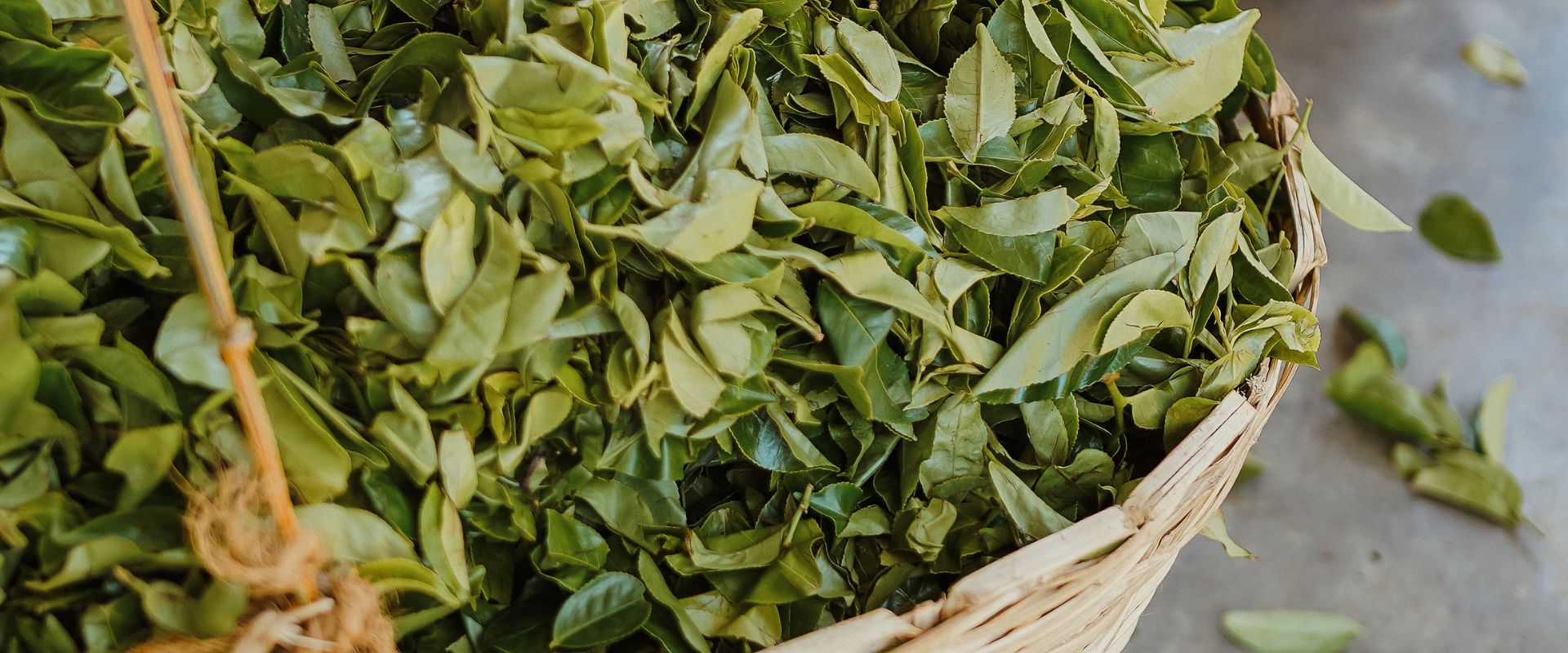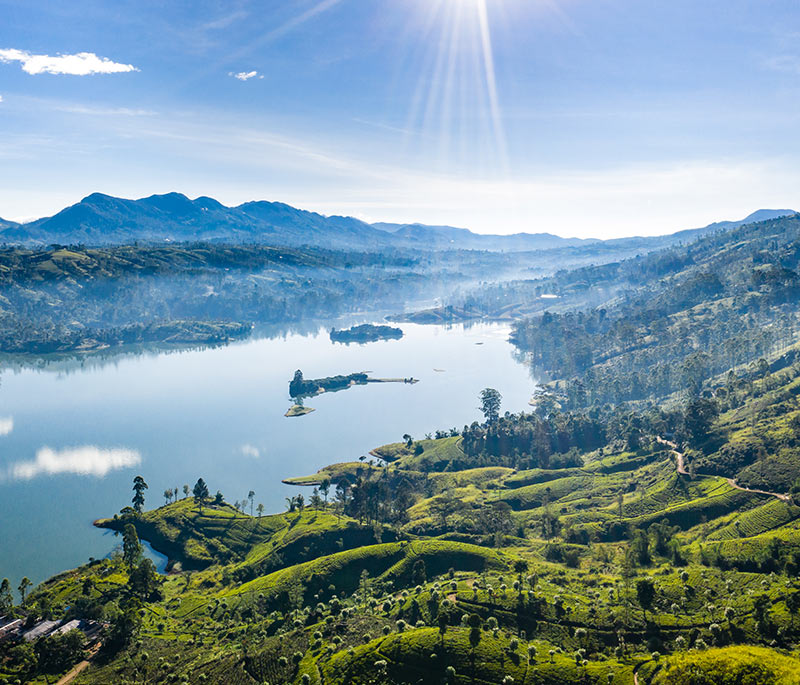The History of Ceylon Tea
The story of tea in Sri Lanka began over two hundred years ago.
British rule was very much under way and in the year 1824, the first tea plant was brought to Ceylon. It came from China and was planted in the Royal Botanical Gardens in Peradeniya for non-commercial purposes.

Fortuitous Timing
James Taylor is widely regarded as the ‘father’ of Ceylon Tea. He hailed from Scotland and arrived on the island in the year 1852. He was sent to the Loolecondera Estate, a coffee plantation in the Kandy District, and was made its manager within five years as Ceylon went on to become the world’s largest coffee producer by 1860. Despite the successes of coffee, the owners of Loolecondera suggested to Taylor that he experiment with tea. It was fortuitous timing as the coffee rust disease first made an appearance two years later, and within the following two decades, coffee was all but wiped out.
In 1866, on the orders of G.D.B. Harrison, proprietor of Loolecondera Estate, Hewaheta (along with W.M. Leake), Taylor collected tea seeds from Peradeniya Botanical Gardens and planted them along the roadsides of Loolecondera. This was in an attempt to make up for the losses borne from the dying coffee plantations. Successfully, within the next 12 months, the first tea estate was born – Field No. 7 – expanding to 19 acres on the Loolecondera Estate, marking the birth of the industry.
This led to Taylor eventually beginning the operation of a fully fledged tea factory at the Loolecondera Estate, and the first sale of Loolecondera tea made in Kandy in 1872. It consisted of two small packs of 23 pounds of tea. The Maskeliya Planter’s Association was established the same year in July as the plantation purposes grew into a fruitful commercial aspect.

Export and Popularity
The first shipment of Ceylon tea, a consignment of 23 pounds – 10 kg, arrived in London for trade in the year 1873. The value was set at Rs. 58; a worthy sum for its value at the time.
Taylor also built the first Tea House or factory in the same year. It was of wattle and daub and had hessian lofts in which to wither the leaf. He was said to have invented a tea leaf roller, which was powered by a 20ft. water wheel. Botanist Henry Trimen succeeded the legendary George Thwaites as Director (previously entitled Superintendent) of the Royal Botanical Gardens, Peradeniya in 1880. Trimen presided over the critical transformation period from coffee to tea and his contribution is therefore considered second to none. The first successful tea-rolling machine was also invented in the same year by the Walker brothers and manufactured by their firm, John Walker & Co.
As Ceylon tea gained popularity throughout the world, the first public auction was held on 30 July, 1883 at the premises of Somerville and Co. along Queen Street now renamed Janadhipathi Mawatha. The Auction itself was only modestly successful with one lot of Kabaragala un-assorted tea selling for Rs. 45 cents a pound, whereas the other four lots remained unsold due to either lack of bids or due to bids received not meeting the Broker’s expectations at the time. The Colombo Tea Auction is considered the oldest and largest tea auction centre in the world. Despite debacles, Somerville & Co. and the other brokers persisted and were able to conduct auctions on a regular basis, promoting the common interest of both buyers and sellers of tea, within the island as well as overseas.
John Walker helped build the first central tea factory in the Fairyland Estate (Mount Pedro) in 1884. The factory belonged to J. A. Rossiter.
Sir Thomas Lipton was said to have visited Ceylon in 1890 and met with James Taylor. Taylor was presented with a tea and coffee service by the Planters Association in 1891, the inscription reading, “to James Taylor, Loolecondera, in grateful appreciation of his successful efforts which laid the foundation of the Tea and Cinchona Industries in Ceylon.” Sadly, he passed away the following year on 2 May.
The growth and production of tea however remained at large and in the year 1894, the Ceylon Tea Traders Association was formed. All tea produced in the island is virtually conducted through this association and the Ceylon Chamber of Commerce at present. Wharran Megginson of the Carolina Plantation, in the Watawala area, commissioned John Walker to build what was to become the prototype factory of the time in the same year, at a cost of Rs 35,000. The design stood the test of time and was little changed over the next half century.
In 1915, Thomas Amarasuriya became the first Ceylonese Chairman of the Planters Association, which was incorporated by an Act of Parliament in 1916. The Tea Research Institute began its operations in the year 1925 as an arm of the Planter’s Association in Nuwara Eliya, conducting research into maximising the yields and methods of tea production. It is the only national body in the island for generating and disseminating new technologies related to tea cultivation and processing.
Flourishing Cultivations
By 1927, tea production on the island exceeded 100,000 metric tons, almost entirely for export. By then tea was not only produced in the highlands, but also in low-elevation areas as a means of expanding cultivation and the growing foreign demand. The humidity, cool temperatures, and rainfall of the country’s central highlands provide a climate that favours the production of high-quality tea. On the other hand, tea produced in low-elevation areas such as Matara, Galle and Ratnapura districts with high rainfall and warm temperature has a high level of astringent properties. The tea biomass production itself is higher in low-elevation areas.
The Ceylon Tea Propaganda Board was established in 1932. In the years that followed the Tea Research Institute commenced work on vegetative propagation at the St. Coombe’s Estate in Talawakele in 1938. The first Ceylonese tea broking house, M/S Pieris and Abeywardena was established in 1941
In 1944, as the estate based trade union became a significant player in the tea plantation sector, the estate owners created a collective movement under the Ceylon Estate Employers’ Federation to balance the bargaining power of this growing trade. The success of the industry had numerous benefactors, across multiple fields over the many initial decades of growth. From the road to the railways, the bridges and tunnels to the botanists and engineers, the surveyors and even politicians, itt was a cohesive and collective contribution that enabled the industry to prosper as it did.

Independence Gained
Our island gained independence in 1948 and continues to be within the British Commonwealth. With this new sense of freedom came the introduction of an export duty on tea 1 October, 1951. Eight years later on 1 June, the Ad Valorem Tax was introduced for teas sold at Colombo auctions.
By 1960, over 200,000 hectares of tea estates produced over 200,000 metric tons of tea, making Sri Lanka one of the leading tea exporters in the world. Accounts of the existing estates and plantations were attempted to be kept; however due to the fact that several had their beginning in coffee before switching to tea, some information throughout the years have been missed.
By 1963, the production and exports of Instant Teas was introduced and in 1965, Sri Lanka had grown to become the world’s largest tea exporter for the first time. The successful milestones are owed to the countless stakeholders, from the plantation workers and tea pickers to the auctions and exporters.
100 Years of Tea
The first International Tea Convention was held in 1966 to commemorate 100 years of the tea industry. From an initial export of a mere 23 pounds, the production of tea had expanded rapidly, and by the turn of the century, exports had risen to 151,000,000 pounds. So too, did the glowing reputation of Ceylon tea, as the industry continued to flourish moving into the 20th Century.
Within the next five years, in 1971 and 1972 the Sri Lankan government nationalised and took over privately to support the tea estates in the country during its drive to nationalise industries of national interest. In 1976, the Sri Lanka Tea Board was founded as were other bodies such as the Janatha Estate Development Board (JEDB), Sri Lanka State Plantation Corporation (SLSPC) and the Tea Small Holding Development Authority (TSHDA) to overlook the government acquired estates. The export of tea bags was introduced then too.
In 1980, our island became the official supplier of tea at the Moscow Summer Olympics. Two years later, the Sri Lankan Tea Manufacturers began the production and exportation of Ceylon Green Tea to global markets. The following year, the crush, tear, curl method (CTC) of processing black tea was introduced and adopted at local tea factories.
In 1987, our island became the official supplier of tea at Expo 88 in Australia. Dilmah, the first producer-owned global tea brand in the world, was launched in Australia in 1988.
In the years to come, specifically 1992 and 1993, many of the government-owned tea estates which had been nationalised in the early 1970s, were privatised once again. On December 21, 1992 the Export Duty and Ad Valorem Tax were abolished and the Tea Research Board was established to further research into tea production. The same year, Sri Lanka celebrated 125 years of tea production by holding the second International Convention of Tea Production in Colombo.
By the year 1996, tea production exceeded 250,000 metric tons. Apart from imports, the turn of the century also brought in the inception of online tea sales which were commended by Forbes and Walker Ltd, at the Colombo Tea Auctions in 2001.
The Tea Association of Sri Lanka was formed in 2002. In the same year, the 1925 vintage Hantana Tea Factory was refurbished by the Sri Lanka Tea Board and the Planters’ Association of Sri Lanka, and was converted into a museum with tea related artifacts and paraphernalia. In 2013, reputed for its signature taste and aroma, Sri Lanka was ranked as the fourth largest tea producer in the world and the world’s largest tea exporter.
The year 2017 marked 150 years ago from the date that James Taylor began the first tea plantation of Sri Lanka in Loolecondera Estate in Kandy. In this year, Ceylon tea was noted as one of the country’s foremost export crops earning an annual revenue in excess of US $1 billion, with the introduction of an abundance of highly innovative, value-added products over the past decade or so. Ceylon tea now enjoys an enviable international reputation. A product that began as a diversification experiment in 1867 spanning just 19 acres of land in Kandy had expanded its cultivation to six principal regions within the country.





